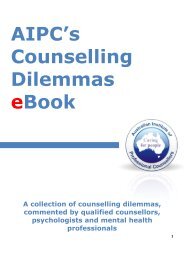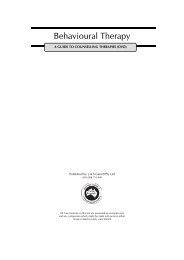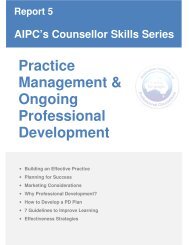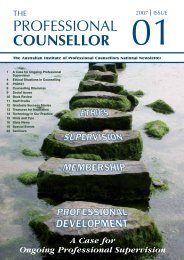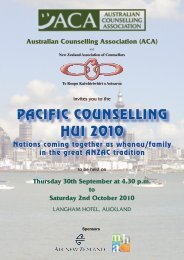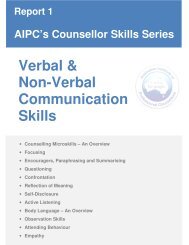Why Diversity? - Counselling Connection
Why Diversity? - Counselling Connection
Why Diversity? - Counselling Connection
- No tags were found...
Create successful ePaper yourself
Turn your PDF publications into a flip-book with our unique Google optimized e-Paper software.
AIPC’s Counsellor Skills Series, Report 3As the counsellor devotes most of their energy to listening to and understanding the client,the client will only see a part of the counsellor's character, and under these circumstances, aclient could perceive the counsellor to be unrealistically caring and giving.Hence, the counsellor's power and the client's biased perception combine to make the clientvery vulnerable to offers of friendship. Conversely, the counsellor is also vulnerable in thecounselling relationship.Inevitably the relationship can develop real closeness as the client shares their innermostand personal thoughts. While counsellors learn to be compassionate and empathic, theirunique client-counsellor relationship can become closer than is appropriate for theprofessional relationship.The role of boundaries: Boundaries are a crucial aspect of any effective client-counsellorrelationship. They set the structure for the relationship and provide a consistent frameworkfor the counselling process.Some boundary lines are clear. Most counsellors would acknowledge that it is ethicallyproblematic, for example, to counsel your ex-partner because the pre-existing relationshipimpairs objectivity and serves to undermine the professional relationship. Whilst situationssuch as these are clearly problematic, outside of such elementary confines are numeroussituations where the delineation of boundaries is less clear. These situations fall outside ofthe formal code of ethics and lie instead in an ambiguous grey area.Boundaries are guidelines that are based on the basic principles of the counsellor’s code ofethics. Corey (1996) briefly outlines five principles in which therapeutic boundaries arebased upon:• Beneficence: a counsellor must accept responsibility for promoting what is good forthe client with the expectation that the client will benefit from the counsellingsessions.• Nonmaleficence: “doing no harm”. The counsellor must avoid at all times, (eveninadvertently) any activities or situations with the client that could cause a conflict ofinterest.• Autonomy: the counsellor’s ethical responsibility to encourage client independentthinking and decision-making, and to deter all forms of client dependency.• Justice: the counsellor’s commitment to provide an equal and fair service to all clientsregardless of age, gender, race, ethnicity, culture, disability and socio-economicstatus.• Fidelity: being honest with clients and faithfully honouring the counsellor’scommitment to the client’s progress.The confusion caused by boundaries is best described by Corey (1996) as a continuum,ranging from disengagement (rigid, inflexible boundaries/guidelines) to enmeshment(flexibility to the point of diffusement) with a large grey area in between that is notoriouslyambiguous and dependent upon the counsellor, the situation and the client’s changingneeds and circumstances. To be an effective counsellor, one cannot disengage from theclient to the extent that the counsellor cannot empathise with the client. That is not thepurpose of counselling and is counterproductive to the therapeutic relationship.Page 18



